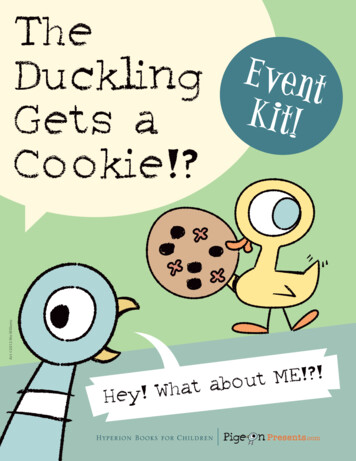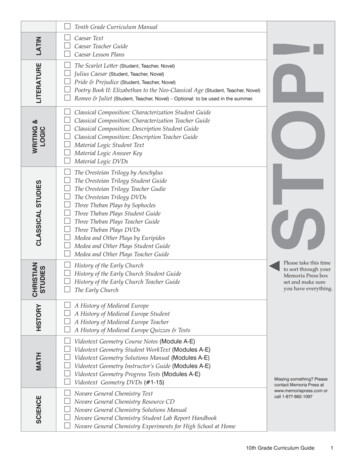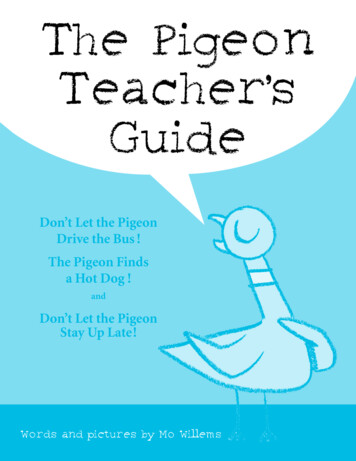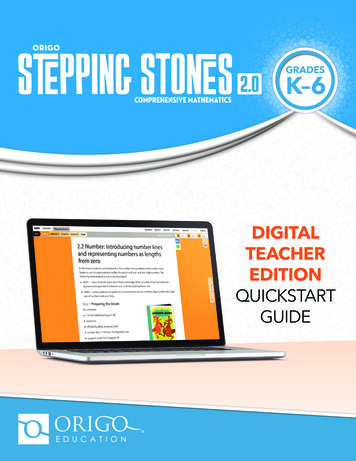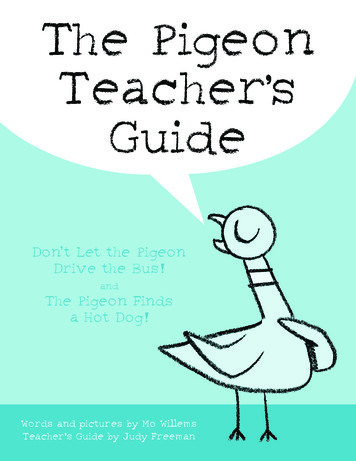
Transcription
The PigeonTeacher sGuideDon t Let the PigeonDrive the Bus !andThe Pigeon Findsa Hot Dog !Words and pictures by Mo WillemsTeacher s Guide by Judy Freeman
Don t Let thePigeon Drivethe Bus!Though the bus driver has warned us, “. . . Don’t let the pigeon drive thebus!” the jaunty blue pigeon uses every trick in the book, from whining totemper tantrums, to convince us, the readers, to let him do just that.INTERACTING WITH THE BOOK:What’s hilarious about this picture book for all ages is watching thatpigeon try to talk us into something forbidden, just like childrendo every day. “Hey, can I drive the bus?” the gimlet-eyed bluepigeon asks you, the reader, straight out. “NO!!!” your listeners willreply spontaneously. They will most likely decide there is no waythey will let that pigeon drive that bus.And aren’t these same kids begging and pleading with their own authority figures to let them stay up late and do forbidden stuff? You might thinkyour young listeners will empathize with the poor pigeon and let him drive,but you will most likely be amazed by how adamant they are.The youngest children can read the pictures and the moods of the pigeonas he tries to fast-talk us into letting down our guard. As you read the bookaloud, acknowledge your listeners’ spontaneous responses (“NO!” “Forgetit!”) as they interact and answer back each of the pigeon’s entreaties.CALDECOTT HONOR:The Caldecott Honor, or silver medal, is given each year to the artistsof the year’s most distinguished American picture books for children.Some readers may look at Willems’s books and call them deceptivelysimple. Willems agrees, but with some clarification.“I’d tweak that to ‘deliberately simple’,” he says. “The essence of my designis to create an immediate, emotional connection. I’m thrilled that anychild can pick up a crayon and quickly create a reasonable drawing ofPigeon; it allows the book to connect with the reader on a fundamental,participatory level.”Discuss with your students:Why do you think the Caldecott Committee chose this book?What is special or memorable about the illustrations?
C mon,say itloud:ACT IT OUT:Have your group stand up and act out the pigeon’srole, emulating his dialogue and especially his bodylanguage as he shifts through a masterful range ofemotions. He is eager, hopeful, cajoling, annoyed,joyful, deflated, doubtful, exasperated, and finallyerupts into a full-blown tantrum: “LET ME DRIVETHE BUS!!!” Examine and analyze that wonderfullyevocative tantrum page, with the explosive yellow andblack lettering, feathers flying, and six images ofPigeon having a meltdown, and then ask your actorsto re-create the scene. Ask them if they can recall everhaving a tantrum and what it felt like.LET MEDRIVE THEBUS!!!!!GET TO KNOWTHE PIGEON:With your children, compile a list of wordsthat describe each of his emotions. Next, listwords that describe the pigeon’s personality.They can draw a picture of the pigeon to goalong with one or more of those words.Examine the illustrations and describe howthe pigeon’s face was drawn to express eachemotion.Dear Mr.Bus Driver,How are you?How isyour bus?Your friend,PigeonI likesunsets,long walkson the beach,and drivingbuses . . .WRITE ABOUT IT:For older children, what is this? It’s a monologue,though one that encourages you, the person on theoutside of the story, to interact and respond. Read thestory aloud again and have children answer each ofthe pigeon’s entreaties out loud (or in writing), givinga variety of good reasons for each response. What afabulous showcase for persuasive writing, one of themany forms writing teachers introduce and model!Ask your students to write a persuasive letter to thebus driver, with clear reasons why the pigeon should,or should not, be allowed to drive. Or have them writeto the pigeon himself.
PERSONALNARRATIVE WRITING:Ask your listeners: What do you do when your parents sayno? Write about a time you tried to talk your parents intoletting you do something. What arguments did you use?What did they say? Were you successful or not? What happened? Have them do a Quick Write describing their experience, and then share their stories aloud.PREDICTING OUTCOMES:When you come to the end, where the pigeon turns andsees the enormous red tractor trailer truck and says“Hey . . .” ask your group to predict what the pigeon will donext. (The back endpaper shows him, once again, dreaming, rapturously, of driving that semi.) One question thepigeon never answers is WHY he wants to drive the busor truck. So children can write and illustrate his reasonsfrom his point of view: “I, Pigeon, want to drive the busbecause . . .”WRITE NEW ADMONITIONS:Children can write and illustrate new cautionary sentences,starting with, “Don’t let the pigeon . . .” (One studentwrote, “Don’t let the pigeon drive the Titanic.”) Or havethem finish the sentence: “Don’t let the pigeon drive thebus BECAUSE . . .” They will come up with all sorts ofinteresting reasons. Be sure to have crayons available sothey can get Pigeon’s coloring just right. They can add hiscomments in dialogue balloons.WRITE ANDILLUSTRATE SEQUELS:Don’t Let the Pigeon Drive the Tractor Trailer Truck! is onepossibility for a sequel, of course. Using dialogue balloons,kids can sketch the pigeon trying to talk his way into thator yet another forbidden activity. Students can fold a largepiece of drawing paper in half three times, which will givethem eight boxes to develop a new story line. Or have eachchild contribute one page and compile a class book.I betyour momwouldlet me . . .Right?It s notjust bussesthat rockmy world.Hmm. .I neverthoughtof drivingtheTitanic .Soundslike fun!Don tworry, I mcute nomatter howyou drawme!
AskAway!I m anopenbook!INTERVIEW THECHARACTERS:With your entire group, or with groups of three, set up aninterview. The moderator interviews first the bus driver andthen the pigeon, asking questions like, “Well, bus driver, whydidn’t you want the pigeon to drive your bus?” and “Say,Pigeon, what kind of driving experience do you have?”DEBATE?No oneever listensto meanyway . . .If thepigeon drove thebus he. . . wouldbe very happy!ThePigeonon thebus goesDrive,Drive,Drive!HOLD A DEBATE:Divide your group into two camps: pro-pigeon-drivingand anti-pigeon-driving. Each group must come up witha list of reasons to support their side. Then, start a debatewith the topic: Should the pigeon drive the bus?“WHAT S THE BIG DEAL?IT S JUST A BUS !”:While we know we can’t possibly allow the pigeon to drive,we nonetheless feel sorry for him and wish we could lethim do it. What would happen if the pigeon did drive thebus? Ask your listeners to predict how Pigeon would beas an actual driver. They can finish the following sentenceand illustrate it: “If the pigeon drove the bus, he .”SING IT OUT:You know you’ll be singing that “Wheels on the Bus” songforever after this one. After singing it the usual way, askyour children to compose some new verses to sing and actout, incorporating the pigeon, such as: “The pigeon on thebus says, “Flap your wings!”
The PigeonFinds a Hot Dog!About to wolf down the hot dog on a bun he has just found, thepigeon is interrupted by a persistent yellow duckling who says,“I’ve never had a hot dog before . . . What do they taste like?”HOT DOG! :The pigeon says to the duckling, “It just tastes like a hot dog,okay!?” What exactly does a hot dog taste like? How would youdescribe it to someone who had never tasted one? After finishingthe book (when Duckling says, “Hmmm . . . needs mustard.”),ask your listeners: “Do you think the duckling has ever tasted a hotdog before? And, by the way, what do you put on YOUR hot dogs?”You might want to serve pigs-in-a-blanket as a follow-up snack.HAVE A TASTE?:The duckling wants a taste of the hot dog. The pigeon doesn’twant to share. He asks you, the reader, “What am I supposed todo?” What COULD he do? How does the duckling get the pigeonto share? What do you do when someone wants a taste of yourfavorite food? What is your favorite food? Would you share itwith someone who asked for some? How would you persuade afriend to share with you?LEARN TO DRAW THE PIGEON . . .AND MAYBE . . . THE DUCKLINGD ow n l o a d t h e “ How to Dr aw the Pige on” she e t fromwww.hyperionbooksforchildren.com website, located on theDon’t Let the Pigeon Drive the Bus! and The Pigeon Finds a HotDog! pages.Have the children follow the step-by-step instructions for drawingthe pigeon. Once they have practiced, they can create their ownscenes or stories using the character. Now try the duckling . . .
I ve hadjust aboutenoughof thatduckling . . .COLOR THE PIGEON:Download the coloring sheet from hyperionbooksforchildren.com website. It is located in the recordfor Don’t Let the Pigeon Drive the Bus! and the recordfor The Pigeon Finds a Hot Dog! Make copies for allthe children and encourage them to color or decoratethem for a pigeon gallery or show.PigeonPuppets?Why didn tI think ofthat?COMPAREAND CONTRAST:The pigeon gets a taste of his own medicine whenthe persistent duckling gets him to share his hot dog.Compare and contrast the pigeon’s relentless hectoringin Don’t Let the Pigeon Drive the Bus! with the duckling’sless direct approach in The Pigeon Finds a Hot Dog!The pigeon and the duckling each try to get their ownway, but they have very different ways of getting whatthey want. Which one works? Why? How?SometimesI feel blue.Other timesyellow,orange &purple.MAKE THEPIGEON PUPPETS:Have children draw and color the pigeon and the duckling on construction paper or oak tag (file folder card).Cut out the figures, and glue them onto paint sticks tomake stick puppets. Working in pairs, kids can thenreenact the dialogue of both books or engage the twocharacters in a new situation.
ABOUT THE AUTHOR:MO WILLEMS has won six Emmy Awards for his writing and animation on Sesame Street andis the head writer for Cartoon Network’s Codename: Kid Next Door. His first book for children,Don’t Let the Pigeon Drive the Bus!, was awarded a 2004 Caldecott Honor by the American LibraryAssociation. His other books include The Pigeon Finds a Hot Dog!, Time to Pee!, and KnuffleBunny: A Cautionary Tale. Mo lives with his family in Brooklyn, New York. Check out his wonderful Web site at www.mowillems.com.JUDY FREEMAN, children’s literature consultant and workshop presenter, is the “Book Talk”columnist for Instructor Magazine and the author of More Books Kids Will Sit Still For: A Read-AloudGuide (Libraries Unlimited, 1995). Visit her Web site at www.JudyReadsBooks.com.This and other teacher resources are available at www.hyperionbooksforchildren.com. Visit theTeachers and Librarians area for a full list of available materials.Books written and illustrated by Mo WillemsPRAISE FOR PIGEON:Don t Let the PigeonDrive the Bus!The PigeonFinds a Hot Dog !Tr. ed. 0-7868-1988-X 12.99 20032004 Caldecott Honor BookALA 2004 Notable BookTr. Ed. 0-7868-1869-7 12.99 2004 “Brilliantly simple . . .”— School Library Journal (Starred Review) “Readers of all ages won’t be ableto resist miming the sly conversationin this satisfying sequel.”—Publishers Weekly (Starred Review)OTHER BOOKS:Time to Pee!Tr. Ed 0-7868-1868-9 12.99 2003A Publishers Weekly Editor’s Pick “Begs to be read again and again.”— The Bulletin of the Center for Children’sBooks (Starred Review) “Preschoolers will howl over the pigeon’sdramatics . . .” — Booklist (Starred Review)Extra Citation for Pigeon/Bus:Capitol Choices 2004Knuffle Bunny:A Cautionary TaleTr. Ed. 0-7868-1870-0 15.99 2004I d also like to trysome sushi whilewere at it, kay?Hyperion Books for Children114 Fifth Ave., New York, NY 10011www.hyperionbooksforchildren.com
Pigeon Drive the Bus! Though the bus driver has warned us, ". . . Don't let the pigeon drive the bus!" the jaunty blue pigeon uses every trick in the book, from whining to temper tantrums, to convince us, the readers, to let him do just that. INTERACTING WITH THE BOOK: What's hilarious about this picture book for all ages is watching that


